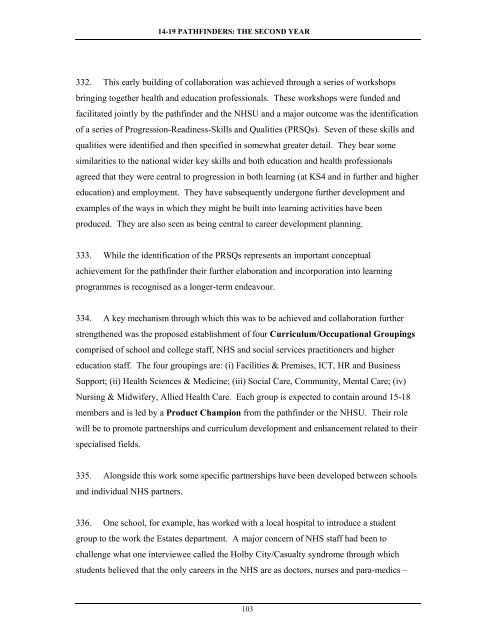Collaborative Approaches to 14-19 Provision - Communities and ...
Collaborative Approaches to 14-19 Provision - Communities and ...
Collaborative Approaches to 14-19 Provision - Communities and ...
- No tags were found...
You also want an ePaper? Increase the reach of your titles
YUMPU automatically turns print PDFs into web optimized ePapers that Google loves.
<strong>14</strong>-<strong>19</strong> PATHFINDERS: THE SECOND YEAR332. This early building of collaboration was achieved through a series of workshopsbringing <strong>to</strong>gether health <strong>and</strong> education professionals. These workshops were funded <strong>and</strong>facilitated jointly by the pathfinder <strong>and</strong> the NHSU <strong>and</strong> a major outcome was the identificationof a series of Progression-Readiness-Skills <strong>and</strong> Qualities (PRSQs). Seven of these skills <strong>and</strong>qualities were identified <strong>and</strong> then specified in somewhat greater detail. They bear somesimilarities <strong>to</strong> the national wider key skills <strong>and</strong> both education <strong>and</strong> health professionalsagreed that they were central <strong>to</strong> progression in both learning (at KS4 <strong>and</strong> in further <strong>and</strong> highereducation) <strong>and</strong> employment. They have subsequently undergone further development <strong>and</strong>examples of the ways in which they might be built in<strong>to</strong> learning activities have beenproduced. They are also seen as being central <strong>to</strong> career development planning.333. While the identification of the PRSQs represents an important conceptualachievement for the pathfinder their further elaboration <strong>and</strong> incorporation in<strong>to</strong> learningprogrammes is recognised as a longer-term endeavour.334. A key mechanism through which this was <strong>to</strong> be achieved <strong>and</strong> collaboration furtherstrengthened was the proposed establishment of four Curriculum/Occupational Groupingscomprised of school <strong>and</strong> college staff, NHS <strong>and</strong> social services practitioners <strong>and</strong> highereducation staff. The four groupings are: (i) Facilities & Premises, ICT, HR <strong>and</strong> BusinessSupport; (ii) Health Sciences & Medicine; (iii) Social Care, Community, Mental Care; (iv)Nursing & Midwifery, Allied Health Care. Each group is expected <strong>to</strong> contain around 15-18members <strong>and</strong> is led by a Product Champion from the pathfinder or the NHSU. Their rolewill be <strong>to</strong> promote partnerships <strong>and</strong> curriculum development <strong>and</strong> enhancement related <strong>to</strong> theirspecialised fields.335. Alongside this work some specific partnerships have been developed between schools<strong>and</strong> individual NHS partners.336. One school, for example, has worked with a local hospital <strong>to</strong> introduce a studentgroup <strong>to</strong> the work the Estates department. A major concern of NHS staff had been <strong>to</strong>challenge what one interviewee called the Holby City/Casualty syndrome through whichstudents believed that the only careers in the NHS are as doc<strong>to</strong>rs, nurses <strong>and</strong> para-medics –103
















